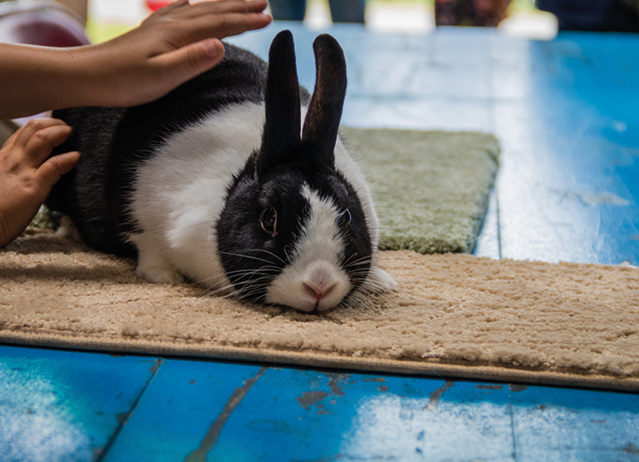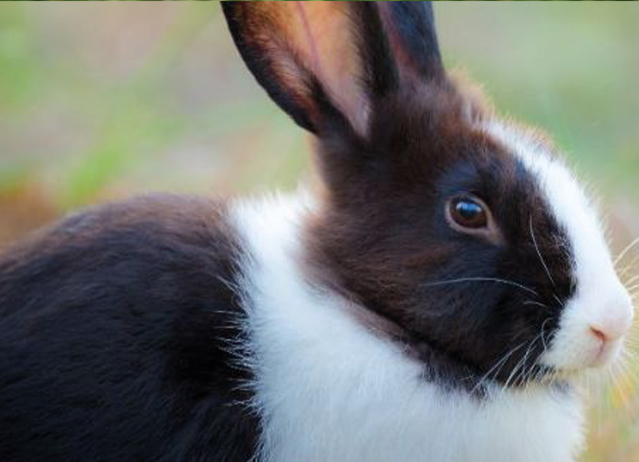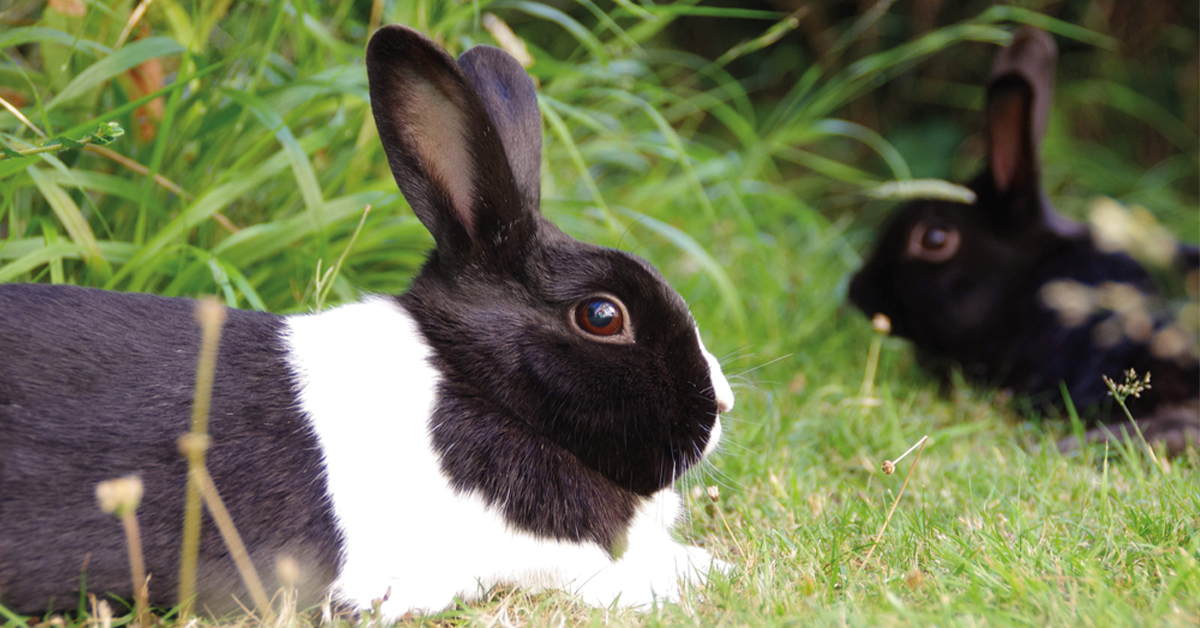About Dutch Rabbits
| Size | Small |
| Weight | 4-5.5 lb |
| Lifespan | 5-8 Years |
| Body Shape | First-time rabbit owners, Couples, Seniors, Indoor rabbits, Families with young children |
| Best Suited For | First-time rabbit owners, Couples, Seniors, Indoor rabbit, Families with young children |
| Top Breed | 4 |
| Temperament | easygoing, energetic, Calm, friendly |
| Comparable Breed | Havana Rabbit, American Rabbit |
Dutch rabbits are readily available in most pet stores, thus popular because they showcase a classic two-toned pattern. With that, they really can make wonderful pets. Much like other rabbits, they do need a little space to play around and exercise, but they also need fresh green vegetables daily. However, if you’re on the lookout for an interactive small pet with a personality, Dutch rabbits could be worth the work. Read on to learn more about these rabbits.
Dutch Rabbit Breed History
This rabbit is one of the oldest domestic rabbit breeds. To be exact, this breed comes from the Petite Brabancon of the county of Brabant, situated in the southern part of the Netherlands, more precisely called Flanders, which had been bred in enormous numbers for the meat industry back in the late 19th century. The Dutch rabbit originated in the country of Holland circa the year 1850 and is called Hollander Rabbit. It was first brought to England in 1864, where it quickly gained much popularity, and has since spread throughout much of the rest of the world.
A good show Dutch rabbit should be quite rounded in the body.
Coat
The Dutch rabbit flyback has a short, shiny, and low-maintenance fur. Much like any other rabbit breed, the Dutch rabbit will also shed in season (like a dog in spring). Then, you would have to groom them more often than usual. For this reason, when they go through molts, you can be assured that, when picking them up and giving them some loving, they will shower you in their fur. Due to this, daily brushing is a must during molt periods; otherwise, one brushing a week should be done.

Colors
Though there are many different types of Dutch rabbits, all are identified by their coats. But in general, even though there are so many types, their markings are almost similar. They have dark-colored ears and rumps, a band of white from the top of their shoulders down to their belly, white legs, and lastly the wedge of white fur running up the front of the face called the ‘Blaze’.
There is the Black Dutch rabbit, which has pure white and slate black fur with dark brown eyes; the Blue Dutch, whose eyes are a blue-grey and fur color a medium-dark blue and glossy; and the Chinchilla Dutch, which has either dark brown or blue-grey and their fur speckled grey mixed with white. There are four more Dutch rabbits that are also recognized in shows, including the Chocolate Dutch, which is either dark brown or ruby eyes and chocolate brown fur. Then there is the Gray Dutch with mixed-colored fur in slate blue, medium tan, then charcoal brown and chocolate, with dark brown eyes. The third would be the Steel Dutch rabbit, with dark brown eyes and a mostly black body with off-white or cream coloration on some of the hair tips. Lastly, there is the Tortoise Dutch rabbit with its bright orange/cream-colored coat and dark brown eyes.
The flyback fur of a Dutch rabbit will be glossy and short with low maintenance.
Care Requirements
Dutch rabbits are one of the oldest domestic breeds available, so you can rest assured they will love being outside their enclosure whenever possible. They will run and jump in the air when they are outside their hut, especially if they are outdoors with some soft grass under their fuzzy little feet.
Like most rabbits, they will live a long and healthy life if they get plenty of outdoor time and are fed 70 percent hay—the rest being a mix of pellets, fruits, and vegetables. There are, however, some fruits and vegetables that can pose a danger to their health. Unless you’ve researched the fruit/vegetable and you’re sure it’s safe to feed it to them, the rule of thumb is simply not to feed them if you are unsure. Other foods that may turn out to be dangerous for your rabbit include seeds from fruits like apples and pears, which include small particles of cyanide. Even though they are harmless when eaten by humans, they can hurt your rabbit. Also, avoid bark and cherry tree twigs. Keep away also from rhubarb, as it contains oxalates that prevent the absorption of calcium, and mushrooms, for it hurts them in the long run. It has been shown that it causes cancer in mice.
Their enclosure could either be indoors or outdoors, depending on the weather and temperature. Rabbits do not fare well in extreme heat, and most of them, just like the Dutch rabbit, are not okay in cold weather. Thus, one should be conscious of outdoor conditions before allowing the rabbit some time out in the open. Their enclosure needs to be clean and free of dung. In the case of hay bedding, clean it at least once every other day.
Now, when talking about the domesticated rabbit, there has always been one age-old question: wire enclosure vs. bedding. Rabbits like bedding since it’s easier on their feet and more comfortable; at the same time, humans would prefer to have wire-bottomed enclosures because it’s easier to clean, but hard on a rabbit’s feet. In the final analysis, the decision is yours; but if you want a happier rabbit, make or purchase an enclosure that has a hay bottom. Of course, this might just take a little longer to clean out their waste, but it does mean that the rabbit is comfortable in its enclosure, and it is not as big of a strain on their poor legs. These should be cleaned out properly once a week while droppings are removed every day.
Health
One important difference between most animals and rabbits is that rabbit teeth never seem to stop growing. Fortunately, they are also constantly being worn down by such normal activities as chewing their food and grinding their teeth. If for some reason your rabbit’s teeth are not being worn down their overgrown teeth may start growing into their jaw and face. The signs of an infection from overgrown teeth include loss of appetite, slugging activity, or drooling around the mouth. Be sure to check on your rabbit frequently for signs of overgrown teeth and take him to the vet if you suspect an infection, as it can be treated with antibiotics, and veterinarians are also competent enough to fix their overgrown teeth problem.
Spaying of females, or does, can take place at four months of age, although vets prefer to do it at six months. Male rabbits, called bucks, can be neutered for three and a half months. All rabbits will also need worm-preventer treatment regularly in addition to a regular check for ticks and fleas.
These rabbits just love to be outside their cage, out in the world.

Temperament/Behavior
These little guys just love to be outside their enclosure and within the world at large. Their gentle nature also makes them a great match with kids, provided they are treated gently and given enough time outside of their enclosures to be social animals. If they stay in their enclosures too long, they will become depressed and/or bored if they don’t have another rabbit present. They make great first pets, relatively speaking since they are pretty easy to care for as long as you can provide them with necessities that keep them safe, healthy, and happy. Because they are very social animals, they will also fit in well with couples and even seniors, so long as retired people can physically manage the rabbit’s requirements—feeding, cleaning up after the rabbit, and all that comes with it.
Rabbits, however, have a different view on training. Activities that human beings would brand unacceptable—urinating in the corner, scratching up your carpet—are completely natural to them, and you have to understand this before trying to train any kind of rabbit. They are also not children in the fact that you should not punish them if they do something unpleasant, as this gets you nowhere with training. Instead, you should only reward them with a treat when they have completed something successfully, such as urinating in the proper area. Never scream or yell at your rabbit if things get frustrating, as they aren’t as obedient as you would like them to be. Rabbits will take you as an enemy and they may become aggressive; they will not like you at all and will refuse to participate further in any training. Owners must approach rabbits with a very patient mindset if they wish to train the rabbit to do anything from potty training to tricks.
Common Health Problems
However, Dutch rabbits can be prone to several health issues. Some common diseases and disorders affecting rabbits include:
- Dental disease1
- Ear mites and infections
- Skin mites and infections
- Eye problems
- Respiratory disease23
- Ileus (gastrointestinal stasis)
- Reproductive organ diseases
All these and many more health issues will require the services of an experienced rabbit veterinarian.
Related: Tan Rabbit

Grooming
Dutch rabbits need regular brushing to remove loose fur and prevent matting, mainly when shedding seasons approach. Be sure to check their nails monthly, trimming them as necessary. When cleaning their ears, do it gently and thoroughly to prevent wax buildup and any infection signs. Regular grooming will keep your Dutch rabbit happy and healthy.
Shedding
Rabbits shed throughout the year, but major molts or sheds occur two times a year in the spring and fall. During these major sheds, your Dutch rabbit will lose more fur than normal.
Brushing
Unless your rabbit gets something caught in his or her fur or is otherwise incapable of normally grooming him or herself due to obesity, arthritis, or some other medical issue, brushing is not normally needed or advised.
Baths
Rabbits are relatively clean animals; thus, there is no need to bathe them at all. If they accidentally get dirty or messy, it would then be a great idea to quickly clean the soiled area. Do not dip your rabbit into the water to bathe them; clean them only at places that need cleaning. Use dish soap and lukewarm water while gently cleaning them, then towel dry thoroughly.
Be very careful not to get water in their delicate ears, and avoid spraying water into them at all costs. Dutch rabbits can get cold during bathes and easily develop ileus from stress, so bath time really should not be done unless necessary.

